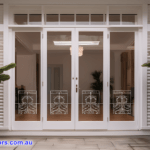
Image that captures the elegance of a grand château, showcasing two symmetrical glass doors with multiple panes and ornate metal handles, transporting readers to the 17th century to explore the birthplace of French doors
Have you ever wondered where French doors originated? Well, we’ve got all the answers for you!
French doors were actually invented in France during the 17th century. They were explicitly designed to reflect the symmetry and proportions of the Renaissance architectural style. These doors, made of a combination of glass and wood, quickly gained popularity due to their ability to let in ample natural light and provide ventilation.
Their popularity spread globally throughout the 18th and 19th centuries. Even today, French doors are highly valued for their elegant aesthetics and versatility.
Key Takeaways
- French doors were invented in France during the 17th century.
- They quickly gained popularity for their ability to let in ample natural light and provide ventilation.
- French doors became a symbol of elegance and sophistication.
- French doors spread globally in the 18th and 19th centuries.
Introduction
French doors were first introduced in 17th century France and quickly gained popularity due to their elegant design and functionality. These architectural fixtures originated during the Renaissance, a period known for emphasising symmetry and proportions. The design of French doors reflected these principles, with two doors that opened outwards to the outdoors. The term ‘French doors’ emerged in England as the French architectural style grew popular and soon became synonymous with this distinctive door type.
The history of French doors is closely tied to their evolution as a global architectural feature. After gaining popularity in Europe, French doors were adapted and adopted by countries worldwide in the 18th and 19th centuries. This international adoption speaks to the enduring appeal and versatility of French doors.
One of the key characteristics of French doors is their ability to allow ample natural light and ventilation through their glass and wood materials. This unique design feature not only enhances the aesthetic appeal of a space but also creates a sense of openness and connectivity with the outdoors. This combination of functionality, elegance, and architectural significance continues to make French doors highly sought after in modern design.
The Birth of French Doors in 17th-Century France
During the 17th century in France, the birth of elegant and versatile architectural fixtures known as French doors occurred. These doors have a rich history and have left a lasting impact on architecture. Here are some key points about the origins and significance of French doors:
- Architectural Style: French doors were influenced by the architectural style of the Renaissance period. They reflected the symmetry and proportions that were popular during this time. The doors were designed to be functional and aesthetically pleasing, combining glass and wood materials.
- Renaissance Influence: The Renaissance period was characterized by a revival of interest in classical art and architecture. French doors drew inspiration from this movement, incorporating elements of balance and harmony into their design. This attention to detail and craftsmanship contributed to their timeless appeal.
- Historical Significance: French doors played a significant role in the history of architecture. They originated as floor-length windows that opened to tiny balconies, allowing ample natural light and ventilation. Over time, they became a symbol of elegance and sophistication, adorning the homes of the French nobility.
- Global Adaptation: After gaining popularity in Europe, French doors were adapted and adopted globally in the 18th and 19th centuries. Their versatility and beauty made them a sought-after architectural feature in countries worldwide. Today, French doors continue to be prized for their historical significance and ability to enhance any space’s aesthetic appeal.
Characteristics and Materials
When it comes to characteristics and materials, you’ll find that French doors are typically made of wood, glass, or a combination of both. These materials are chosen for their durability, aesthetic appeal, and ability to let in natural light. French doors come in different types, including single- or double-hung, sliding, swinging, or folding, allowing for various installation options depending on your needs and preferences.
One of the advantages of French doors is their ability to let in ample natural light, making your space feel brighter and more open. The glass panels also provide a clear view of the outdoors, allowing you to enjoy the scenery even when the doors are closed. Additionally, French doors can improve ventilation, allowing fresh air to circulate throughout your home.
However, there are also a few disadvantages to consider. French doors with glass panels may require more maintenance than solid doors, as the glass can accumulate fingerprints and smudges. Regular cleaning and polishing are necessary to maintain their clarity and shine. Wood French doors may also require occasional refinishing or repainting to prevent damage from moisture and sunlight.
In terms of modern designs, French doors have evolved to incorporate sleek lines and minimalist aesthetics, making them suitable for contemporary homes. They can be customized with different finishes, hardware, and glass options to match your interior or exterior design theme.
Historically, French doors have played a significant role in architectural styles, reflecting the elegance and symmetry of the Renaissance period. They have been adapted and embraced globally, becoming a timeless and iconic feature in many homes.
Growing Popularity in the 18th and 19th Centuries
The popularity of French doors soared in the 18th and 19th centuries as they gained recognition for their elegant design and practical functionality. Here are some key points about the growing demand and historical significance of French doors during this time:
- Architectural Adaptation: As French doors became fashionable in Europe, other countries began adopting the French style in their architecture and home design. The symmetrical proportions and abundant use of glass in French doors allowed for bringing the outdoors in, creating a sense of openness and elegance.
- Global Influence: French doors, originally a hallmark of French architecture, started to spread globally during the 18th and 19th centuries. Their versatility and aesthetic appeal made them a sought-after feature in homes worldwide. French doors symbolised refined taste and sophistication from Europe to America.
- Evolving Designs: Over time, the design of French doors evolved to accommodate changing architectural trends and functional needs. While the basic concept of glass panels framed by wood remained the same, variations in panel arrangements, hardware, and decorative elements emerged. This continuous evolution contributed to the enduring popularity of French doors.
- Historical Significance: The growing popularity of French doors in the 18th and 19th centuries marked a significant shift in architectural preferences. They represented a departure from the heavy, ornate styles of the past, embracing a more open and light-filled aesthetic. French doors symbolised modernity and elegance, leaving a lasting impact on architectural history.
Overall, the growing demand for French doors during the 18th and 19th centuries, their architectural adaptation worldwide, evolving designs, and historical significance make them a fascinating aspect of architectural and design history.
Key Uses and Benefits Today
Today, homeowners and businesses appreciate French doors’ versatility and aesthetic appeal. They use them to create an open and inviting atmosphere while maximizing natural light. French doors have become a popular choice in various settings, from residential homes to commercial spaces, due to their ability to enhance the overall ambience of a room.
One of the key uses of French doors today is to increase natural light in interior spaces. French doors allow sunlight to stream in by incorporating glass panels into the design, creating a bright and airy feel. This adds a sense of warmth and comfort to the room and reduces the need for artificial lighting during the day, making them energy efficient.
Furthermore, the aesthetic elegance of French doors is highly sought after. Their timeless design, characterized by the combination of glass and wood, adds a touch of sophistication to any space. Whether used as a partition in an open-plan office or as an entryway between rooms in a home, French doors can elevate the overall visual appeal of the area.
The versatility of French doors is another reason for their continued popularity. They can be installed as interior or exterior doors, allowing for seamless transitions between indoor and outdoor spaces. Additionally, French doors can be used as room dividers, creating a sense of privacy without completely obstructing the flow of light.
Conclusion
Imagine French doors’ elegance and versatility in any space, making them a timeless choice for residential and commercial settings. French doors have significantly influenced architecture and design throughout history, with their origins dating back to 17th century France.
Here are four key points to consider about the historical significance, design evolution, global adaptation, and modern variations of French doors:
- Influence: French doors emerged during the Renaissance period and reflected the symmetry and proportions of the era. They quickly gained popularity in France and eventually spread across Europe and the rest of the Western world.
- Historical Significance: The term ‘French doors’ originated in England as the French architectural style grew popular. These doors were prized for allowing ample natural light and ventilation through their glass and wood materials, enhancing the aesthetic appeal of any space.
- Design Evolution: Over time, French doors have evolved in their design and functionality. While the basic concept of a door with glass panels remains, modern variations include different framing materials, finishes, and hardware options to suit various architectural styles and personal preferences.
- Global Adaptation: French doors were adapted globally in the 18th and 19th centuries, as they became a symbol of elegance and sophistication. They can be found in traditional and contemporary architectural styles, adding a touch of timeless beauty to buildings worldwide.
What is the history and origin of French doors?
French doors originated in France during the Renaissance period. They were designed to bring more natural light into rooms and provide a sense of openness. Reasons to choose French doors include their elegant design, ability to create a seamless transition between indoor and outdoor living spaces, and their timeless appeal.
Are French Doors Originally from France?
Yes, French doors originated in France during the Renaissance period. These doors consist of window panes or panels and are usually hinged to open outward. Identifying French door manufacturers can be a helpful way to choose high-quality doors for your home.
Frequently Asked Questions
How Did French Doors Get Their Name?
French doors got their name from the French architectural style that inspired their design. The term ‘French doors’ emerged in England as the French influence grew popular, reflecting the origin and etymology of their name.
What Architectural Styles Influenced the Design of French Doors?
French doors, with their elegant design and versatility, were influenced by various architectural styles. The Renaissance period inspired their symmetry and proportions, while England’s popular French architectural style gave them their name.
How Have French Doors Evolved in Terms of Design and Materials?
French doors have evolved in terms of design and materials. We have seen the evolution of functionality with innovative materials and modern methods. Sustainability considerations and technological advancements have also played a role in their development.
Are There Any Specific Countries or Regions With a Strong Association With French Doors?
In terms of association, French doors have a rich history and cultural significance. They gained popularity in Europe and were adapted globally in the 18th and 19th centuries. The craftsmanship and elegance of French doors make them a sought-after architectural fixture.
What Are Some Common Misconceptions or Myths About French Doors?
Common misconceptions about French doors include that they are only for exterior use, when they can also be used indoors. Some may mistakenly believe that French doors are difficult to install, but the process can be straightforward with proper guidance.

I’m James Davis, a carpenter with eight years of experience in carpentry services, repairs, installations, renovations, and maintenance of interior doors. I have a diploma in carpentry and joiner trade from the Education Skills Australia Institute and take pride in delivering high-quality results to ensure customer satisfaction. I’m a blog writer for Octopus Doors Company and enjoy sharing my knowledge and tips on maintaining security measures and choosing the right door materials, paints, or handle styles. I specialize in custom-made interior doors and strive to make every home look fabulous. Contact me anytime for help with door-related issues.










